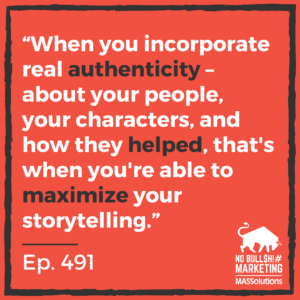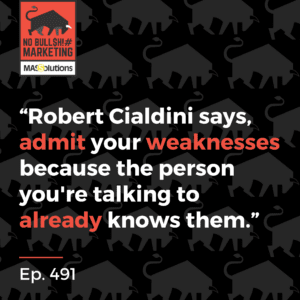Podcast
491: The ROI of Invisible Contributions: Seinfeld Storytelling Part 2
EPISODE SUMMARY
Have you ever thought about telling the stories of the important people working behind the scenes in your company? People remember stories because of the characters in them, so this can be a great way of improving your ROI. In episode 491, Dave Mastovich talks about how to incorporate part two of the Seinfeld storytelling approach.
EPISODE TRANSCRIPT
It’s the No Bullshit Marketing Show. I’m Dave Mastovich, CEO and founder of MASSolutions, the world’s only No Bullshit Marketing consultants. Seinfeld is one of the most famous sitcoms in television history. It is now multi-generational, meaning that back then there were two or three generations watching that still enjoy the reruns, but younger generations have been exposed to Seinfeld, and have begun to know what the terms are and the catchphrases, the characters, and so forth. At MASSolutions, we have the Seinfeld storytelling approach, which is our way of applying some of the tenets of the Seinfeld experience, the sitcom, and all the history, and helping you as a No BS storyteller to apply the same things that worked for Seinfeld, when reaching all of us, for you, to reach those people you have to reach in your life and your business.
In fact, last episode, we went over the first part of the Seinfeld storytelling approach that we use at MASSolutions, and it’s discovering the everyday genius in your company. Because the show Seinfeld is supposedly about nothing, when we all know it’s about the minutiae of everyday life, and it’s actually even more than that. It’s about us, it’s about the people in our lives. It’s about how we handle what’s going on and the amusement in the everyday things that happen in life. Well, Seinfeld storytelling approach part one at MASSolutions is that what you think is nothing is actually something to others. So we went over that in the previous episode, check it out. But this one is about the Seinfeld storytelling approach part two, the ROI. The return on investment of invisible contributions at your company. That’s MASSolutions Seinfeld storytelling approach part two.
What does it mean? Well, stories are about people, and Seinfeld was certainly about people. Let’s take the main characters. As soon as you see an image of Jerry, Elaine, George and Kramer, you immediately think certain things. You immediately begin to remember the story of Kramer, the personality of George, that smile and the pushing of Elaine, and then Jerry’s humor, and how he took the approach to all the things that happened in everyday life. Seinfeld’s storytelling approach part two is that you have people, you have characters at your company that are bringing an ROI to your company and your customers or your clients. Think about it. Seinfeld had all those people, all of those characters. I want you to think differently. I want you to think of the people that are characters at your company. Seinfeld had George’s dad, Mr. Costanza. There’s probably somebody that’s a little loud at your company. But they bring value or they wouldn’t be there. Seinfeld had his parents. And the more we watched that, we relate to it, either our parents, or as people get older start to think maybe I’m doing some of these things. One of my favorites is this one character was so talented, and so good at what he does, and had such a competitive advantage, that he was allowed to be difficult, irascible, irrational, ‘No soup for you.’ We have that sometimes in our companies. Hey, when you work in a creative field like MASSolutions, there are people that are like that, that have that talent, but, ‘No soup for you.’ And you have to kind of learn how to manage them. Heck, some of us might have even been that person earlier in their career. So stories are about people. And the Seinfeld storytelling approach here at MASSolutions part two is that you have characters at your company that you’re not humanizing, that you’re not taking the authenticity behind them, and you’re not telling their story. 
I worked with one client that was a wealth management company and would bring people into the office and go over how they were going to have strategies and when they were going through their pitches, they were role playing with us. And we tweaked some messaging and helped them in different ways. And one name that kept coming up was they kept mentioning Penny. And I said, ‘Okay, just as a throw away at the tail end of a prospect meeting or client annual meeting or quarterly meeting, say, don’t forget the Penny factor, you get the Penny factor. And then they’ll naturally say, ‘The Penny factor, what’s that?’ They’ll say, ‘Oh, Penny, she’s the one that predicts what our clients are going to need, what each of us need. She’s the one that handles everything, is able to make things happen, we call it the Penny factor.’’ They started using this and I get a text, ‘You’re not gonna believe this.’ And then I get a call. ‘This is working, everybody’s remembering. They’re saying I remember when she did this, and I enjoyed when she took care of that.’ So they weren’t even thinking in terms of that. They were talking about the investment services they were doing and the way they were helping the family, and all these other things they were doing as a wealth management company, but the ROI of that invisible contribution of Penny wasn’t being maximized. So they started using the Penny factor.
You have your Penny, you have your, ‘No soup for you.’ You have your Mr. Costanza, but they also bring tremendous value. Now, it’s not just that part of it. The second part is, we remember stories because of people. Each of those ones I just told you, or if I talked about the Chinese restaurant, Seinfeld episode Chinese restaurant, it’s famous, because it was the first show on a major network to be shot in one room. But as I talked about the Chinese restaurant, many, many, many Seinfeld fans are already envisioning and seeing that guy that maitre d, standing at that little fake podium table and saying what he would say to them. That’s because we remember people. So we want to be able to incorporate our clients’ success stories when talking to other clients with permission. If you say, ‘Hey, this worked really well, would you mind if I brought that anecdote up?’ And you use anecdotes and analogies about people because you’re talking to a person. When you’re talking to a prospect or a client, you’re talking to a person, and stories about people are going to resonate with them. So you need to build your imagery of anecdotes and analogies around people, your stories around people that are authentic, and real.
But there’s another piece to this. As these things called humans, which people around me know I say this a lot, ‘Hey, what’re these things called? Humans.’ We have these things called weaknesses. And we’re going to notice those weaknesses. People know the weaknesses of companies and people. So one of the things that we’ve been taught to do is kind of hide our weaknesses, not bring up our weaknesses. Fortunately, there’s a shift now, in the last decade or two, where you’re seeing more and more vulnerability out there. But we’ve been taught to kind of keep those weaknesses over here. When the people we’re dealing with know the weaknesses of our company, Robert Cialdini, I mentioned him a lot, professor at Stanford, one of the foremost thinkers and writers and authors and speakers about the principles of influence, says, admit your weaknesses because the person you’re talking to already knows them. Well, telling stories about people can quickly get those weaknesses out there about what’s going on with your company and how you are fallible because you’re human, and so are the people who work there. But then you offset that by saying, ‘And here are the strengths.’ And when you tell that in a story about people, and you tell that story, if you tell a story about Kramer, he would sound a little odd. But Kramer loved Jerry and Elaine and George and those four are really good friends. And there were good qualities to them and there were good things that they did. The same thing with your people, your characters.
 So you want to be able to also maximize that principle of influence that Robert Cialdini said was, admit your weaknesses. And when you do that in an authentic manner by telling a story that involves your people, your characters, and points out maybe something where they’re a little rough around the edges or maybe they’re green or maybe they are a soup Nazi, maybe they are that super talented person. ‘Hey, we’re working with him. We’re working with her. We’re talking to him. We’re trying to get them, but they’re a little rough around the edges.’ But hey, you know what, they create magic. You incorporate people. So it’s the second part of the Seinfeld storytelling approach. And all this ties into your No BS story builder, which is the way we build stories. Because when you tell stories about people, and you talk about who helped and how, the obstacles that were overcome, the struggles and barriers along the way, and the lessons learned, that’s when the story is processed most quickly by your target audience. That’s when it resonates the most. So when you incorporate real authenticity – about your people, your characters, and how they helped, the lessons learned, what all was overcome, how we got to this point, how we listen to you, the prospect, to be able to deliver this product or service for you – that’s when you’re able to maximize your storytelling. So Seinfeld storytelling approach part two here at MASSolutions is about the ROI of invisible contributions because stories are about people. And believe me, you’ve got your characters just like Seinfeld had theirs.
So you want to be able to also maximize that principle of influence that Robert Cialdini said was, admit your weaknesses. And when you do that in an authentic manner by telling a story that involves your people, your characters, and points out maybe something where they’re a little rough around the edges or maybe they’re green or maybe they are a soup Nazi, maybe they are that super talented person. ‘Hey, we’re working with him. We’re working with her. We’re talking to him. We’re trying to get them, but they’re a little rough around the edges.’ But hey, you know what, they create magic. You incorporate people. So it’s the second part of the Seinfeld storytelling approach. And all this ties into your No BS story builder, which is the way we build stories. Because when you tell stories about people, and you talk about who helped and how, the obstacles that were overcome, the struggles and barriers along the way, and the lessons learned, that’s when the story is processed most quickly by your target audience. That’s when it resonates the most. So when you incorporate real authenticity – about your people, your characters, and how they helped, the lessons learned, what all was overcome, how we got to this point, how we listen to you, the prospect, to be able to deliver this product or service for you – that’s when you’re able to maximize your storytelling. So Seinfeld storytelling approach part two here at MASSolutions is about the ROI of invisible contributions because stories are about people. And believe me, you’ve got your characters just like Seinfeld had theirs.
Thanks for listening to another episode of the No Bullshit Marketing Show, recorded here in MASSolutions studio in bold, beautiful, downtown Pittsburgh, Pennsylvania. Remember, ask yourself, what’s the big idea? And build your story around the answer. It’s all about bold solutions. No BS.
Important Links
Listen Here
 |
 |
 |
 |
 |











